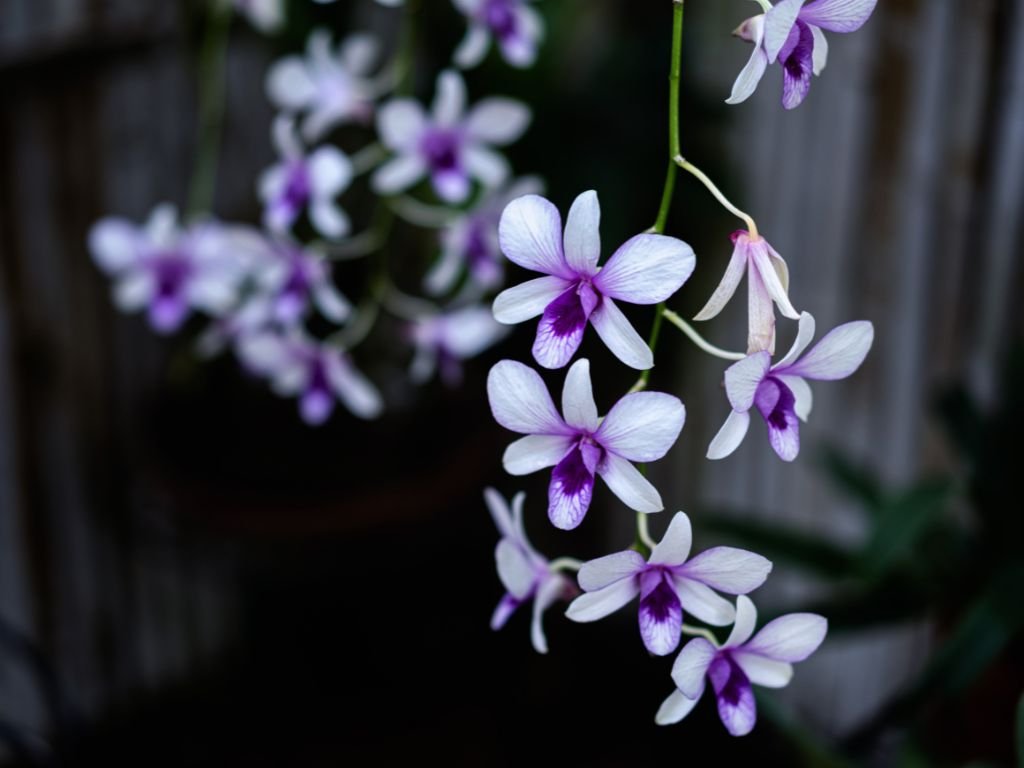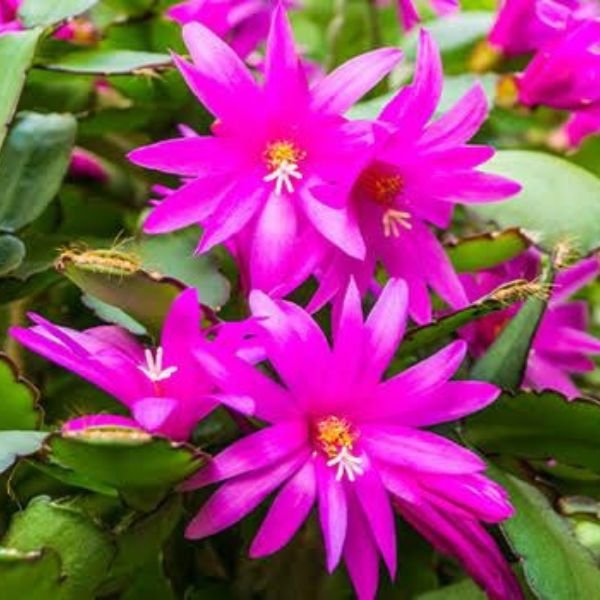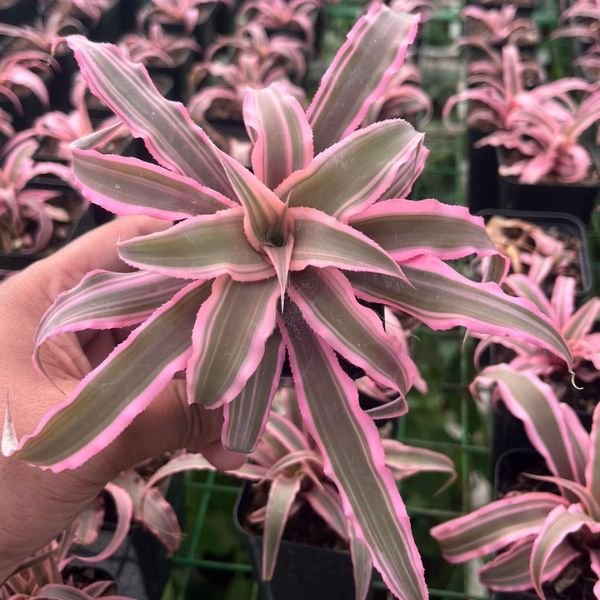Dendrobium orchids are native to tropical regions of Asia and come from the Orchidaceae family. These orchids typically grow during the warmer months, with new shoots and roots emerging in spring and summer. During this time, they require plenty of water and fertilizer to support their growth. As fall approaches and temperatures start to cool down, dendrobium orchids enter a resting period, during which they require less water and nutrients. Most dendrobium orchids bloom twice a year, typically in late winter and fall or early spring, although some species may bloom once a year. The exact timing of the bloom depends on the specific species and growing conditions.
The blooms of dendrobium orchids can last up to 6-8 weeks, and for some species, it extends up to 3 months depending on the species and growing conditions. Some species produce blooms that last for only a few days, while others can produce flowers that last long. Dendrobium Orchids can be seen growing on trees and are the easiest orchids among the other species. They are easy-care orchids. Dendrobiums are beginner-friendly that are available in different colors and sizes. The noticeable thing is these orchids last for 10 to 15 years.
Classification of Dendrobium Orchids
In some cases, Dendrobiums are divided into two classes: soft-caned and hard-caned. But the right classification of Dendrobiums includes 5 types of Dendrobiums. The names of the types of Dendrobium are as follows: Dendrobium Phalanoepsis, Normal Dendrobium, Dendrobium Spatulata, Dendrobium Latouria, and Dendrobium Formosae.
Dendrobium Phalaenopsis
Dendrobium phalanoepsises are the most known Dendrobiums among other orchid species. They are noted for tall pseudobulbs and bunchy flowers on a single spike. They have dark-colored leaves and multiple colored flowers which make them unique from the rest. Beginner-friendly Phalanoepsis always prefer a warm environment to grow. Regular watering and weekly fertilization in the growing period are necessary, reduce the amount after that. The bright placement and a drop in temperature at night are also considerable for caring for these orchids. In the resting period, provide them with a slightly lower temperature than usual.
Normal Dendrobium
Normal Dendrobiums produce pendulous-like blooms for instance of Dendrobium Nobile. They grow in cool climate places of Thailand, Vietnam, Nepal, and high altitude areas like the Himalayan regions. They don\’t require much watering and fertilization except during the growing period. These Dendrobiums can survive in low temperatures and need no water in winter. But putting in bright indirect light and maintaining humidity level is important for these Dendrobiums.
Dendrobium Spatulata
Dendrobium Spatulata is famous for its large spiral or twisted blooms. These are tropical and epiphytic plants. Spatulata is available in many attractive colors. Their upright inflorescences from the top of cane-like pseudobulbs produce multiple flowers. Unlike phalaenopsis, they don\’t need a resting period. Keep the high humidity and good air circulation in the place of these Dendrobium orchids. They need an appropriate amount of frequent watering (not waterlogged) and fertilization in the growing time. Otherwise, moderate watering, warm temperature, and weekly fertilization are enough for the optimal growth of these Dendrobiums.
Dendrobium Latouria
Dendrobium Latourias bring short colorful flowers and broad leaves. They prefer bright light conditions, and warm to moderate temperatures to survive. Increase the watering and fertilization in the growing time and decrease the other times. Beginners can benefit greatly from cultivating these orchids, as they possess a remarkable ability to withstand our techniques in nurturing them.
Dendrobium Formosae
Dendrobium Formosae\’s other name is Nigrohirsutae. It mostly gives large and long-lasting white flowers with various colors in different sections compared to other dendrobiums. These dendrobiums originate from cool sections of Southeast Asia. The Formosae spices can easily be distinguished by their black hairs. The ideal temperature for Formosae varies on the species, some need cool and some prefer warm temperatures. Daily watering and fertilization in the growing stage of these plants are needed to get the best growth and reduce both at other times. No need for fertilization and less watering in winter work best for the good health of Foemosea Dendrobiums.
Temperature
Dendrobium orchids are heat-tolerant plants and can stand in high as well as cold temperatures. Keeping the day temperature anywhere between 18°C to 30°C and a little less temperature from 13°C to 18°C at night. Some Dendrobium species can tolerate the cool temperature while other tropical dendrobiums are not.
Watering
Dendrobium orchids prefer watering in the morning. Excess water under the pot will make the root of orchids rot. After feeling the dryness of the soil, water the dendrobium orchids. The amount and frequency of watering depending on the potting medium. You can water dendrobiums regularly or every 2-3 days or weekly to maintain the soil\’s moderate moisture, not waterlogged. Keep a good drainage system to avoid sitting your plants in water.
Light
Maintaining the requirement of light is crucial for the flowering of dendrobium orchids. Dendrobiums grow well in bright light. Direct sun can hinder the growth of these orchids. For indoor planting, consider placing the dendrobiums in the east or southeast window to get proper bright indirect light.
Humidity and other requirements
Dendrobiums require a high humidity level minimum of 50% to 80%. In case of low humidity, you can use a water-filled tray near the Dendrobium or use a humidifier to increase the humidity level.
Fertilization
Fertilize twice in the growing months and once fertilization in winter work for the growth of Dendrobium orchids.
- Apply a solution of 1 gram of well-balanced fertilizer (20-20-20 NPK) per liter of water.
- Any other balanced fertilizer filled with nitrogen, potassium, and phosphorus can be used.
Potting Medium and repotting
Choose a small pot with drainage holes by measuring the roots of Dendrobium plants. Normal soil for growing generic flowering plants is not good for Dendrobiums. They need a potting medium with a mixture of fir bark, perlite, charcoal, and peat moss or use coconut husk. Repotting the dendrobium orchids into a large pot every 2 to 3 years by checking the root condition. Don\’t forget to prune the damaged roots and size the roots according to the new container before repotting.
Pests, diseases, and other problems related to Dendrobium
Pests like mealybugs, aphids, and two-spotted spider mites are common for dendrobium orchids. Some fungal diseases can give black rots, and spotted leaves to the dendrobium orchids. Before damaging the whole parts of the orchid, use fungicides like Thiphanate Methyl or any other according to the fungal disease. To get rid of pests, apply Rubbing Alcohol and any homemade pesticide. Other problems like yellow leaves and rotten roots can be caused by overwatering. Rot roots, yellow leaves, and mismatched green color are the signs of dendrobium dying. Overwatered orchids looked very dull. But to revive these orchids, cut the damaged roots and dry out the remaining roots. Repotting the undamaged part with a new potting medium and only water when the top inch of the soil is dry. No need to cut the yellow leaves, instead let them automatically fall off. Brown spots and edges on the leaves are the result of either bacterial diseases or too much fertilization. It\’s good to cut the brown leaves as they are not of any use to the dendrobium orchids.
Other information about Dendrobium Orchids
Dendrobiums typically require three to nine months to bloom before they can gather enough energy for re-blooming. However, there are instances where orchids may need additional assistance to prolong their blooming period, necessitating increased attention. Make sure to give adequate light, a little low temperature at night, fertilization, and watering before and after flowering to extend and encourage bloom and reblooming. Proper lighting plays a big role in the blooming of these orchids. Failed blooming or re-blooming for years is caused by low lighting. Keep your orchids in bright light conditions to encourage blooming. Once the orchid\’s flowers have dropped, you can prune off dead stems and roots with sharp scissors for boosting growth.







